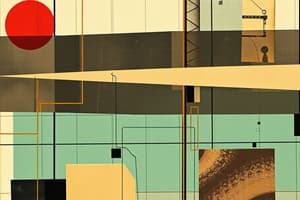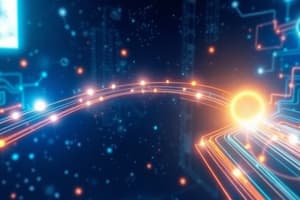Podcast
Questions and Answers
Communications are governed by predetermined rules known as protocols.
Communications are governed by predetermined rules known as protocols.
True (A)
Which of the following processes is NOT typically described by networking protocols?
Which of the following processes is NOT typically described by networking protocols?
- The format or structure of a message
- The color of the network cables (correct)
- How networking devices share information about pathways
- The setup and termination of data transfer sessions
What is the primary benefit of using standards in protocol development?
What is the primary benefit of using standards in protocol development?
Ensuring products from different manufacturers can work together.
The OSI model was designed by the International Organization for ________ (ISO).
The OSI model was designed by the International Organization for ________ (ISO).
How many layers does the OSI model have?
How many layers does the OSI model have?
Match the following OSI layers with their function:
Match the following OSI layers with their function:
The TCP/IP model has more layers than the OSI model.
The TCP/IP model has more layers than the OSI model.
In the context of protocol models, what is a PDU?
In the context of protocol models, what is a PDU?
What is the general term for the PDU at the Application layer?
What is the general term for the PDU at the Application layer?
A Layer 2 address is also known as a _________ address.
A Layer 2 address is also known as a _________ address.
Layer 3 addresses are also called MAC addresses.
Layer 3 addresses are also called MAC addresses.
Which layer is also called port number?
Which layer is also called port number?
What is the function of repeaters and hubs, and at which layer of the OSI model do they operate?
What is the function of repeaters and hubs, and at which layer of the OSI model do they operate?
A collision domain is also referred to as a network _________.
A collision domain is also referred to as a network _________.
Hubs perform traffic filtering.
Hubs perform traffic filtering.
At what layer of the OSI model do switches operate?
At what layer of the OSI model do switches operate?
What are the five basic operations that switches use?
What are the five basic operations that switches use?
Routers make forwarding decisions based on _________ addresses and operate at Layer _________ of the OSI model.
Routers make forwarding decisions based on _________ addresses and operate at Layer _________ of the OSI model.
Which of the following is NOT a valid address included to successfully deliver the data?
Which of the following is NOT a valid address included to successfully deliver the data?
A device transmitting data across a network will encapsulate the PDU from the layer above and rename it so that it reflects its new appearance.
A device transmitting data across a network will encapsulate the PDU from the layer above and rename it so that it reflects its new appearance.
Flashcards
Protocols
Protocols
Predetermined rules that govern communications.
Standard
Standard
A protocol endorsed by the networking industry and ratified by a standard organization.
Reference model
Reference model
Aids understanding of communication functions and processes.
OSI model
OSI model
Signup and view all the flashcards
Application Layer (OSI)
Application Layer (OSI)
Signup and view all the flashcards
Presentation Layer (OSI)
Presentation Layer (OSI)
Signup and view all the flashcards
Session Layer (OSI)
Session Layer (OSI)
Signup and view all the flashcards
Transport Layer (OSI)
Transport Layer (OSI)
Signup and view all the flashcards
Network Layer (OSI)
Network Layer (OSI)
Signup and view all the flashcards
Data Link Layer (OSI)
Data Link Layer (OSI)
Signup and view all the flashcards
Physical Layer (OSI)
Physical Layer (OSI)
Signup and view all the flashcards
Protocol Data Units (PDU) names
Protocol Data Units (PDU) names
Signup and view all the flashcards
Data (PDU)
Data (PDU)
Signup and view all the flashcards
Segment (PDU)
Segment (PDU)
Signup and view all the flashcards
Layer 2 address
Layer 2 address
Signup and view all the flashcards
Layer 3 address
Layer 3 address
Signup and view all the flashcards
Repeater
Repeater
Signup and view all the flashcards
Hubs
Hubs
Signup and view all the flashcards
Bridges
Bridges
Signup and view all the flashcards
Routers
Routers
Signup and view all the flashcards
Study Notes
Rules and Protocols
- Communication relies on protocols, which are predetermined rules.
- Protocols define the format/structure of messages.
- Protocols also manage information sharing between networking devices about pathways, error/system message handling, and session setup/termination.
Standards
- A standard is a protocol endorsed by the networking industry, ratified by a standards body like IEEE or IETF.
- Standards ensure interoperability of equipment from different vendors.
Reference Models
- Designed to aid in understanding communication functions and processes.
- Used for network design, operation specifications and troubleshooting.
- Primary models are OSI and TCP/IP.
OSI Model
- The Open Systems Interconnection (OSI) model was created by the International Organization for Standardization (ISO).
- Intended to provide a framework for Open Systems Protocols.
- Contains 7 layers: Application, Presentation, Session, Transport, Network, Data Link, Physical.
- Each layer is responsible for specific functions governed by protocols.
TCP/IP Model
- Consists of four layers: Application, Transport, Internet, and Network Access.
OSI vs. TCP/IP Model
- OSI Application, Presentation and Session Layers map to the TCP/IP Application layer.
- OSI Transport layer also the TCP/IP transport layer.
- OSI Network layer also the TCP/IP Internet layer.
- OSI Data Link and Physical Layers map to the TCP/IP Network Access layer.
Encapsulation and Decapsulation
- Data is passed down the stack during encapsulation, where each layer adds headers.
Protocol Data Units (PDU)
- A Protocol Data Unit (PDU) is the form data takes at each layer.
- Each layer encapsulates the PDU from the layer above it.
- Application Layer PDU = Data.
- Transport Layer PDU = Segment (T-PDU).
- Internetwork Layer PDU = Packet (N-PDU) or datagram.
- Data Link or Network Access Layer PDU = Frame.
- Physical Layer PDU = Bits.
Addressing
- A data stream is divided into pieces which are interleaved with messages traveling to different destination hosts.
- Addresses are necessary to ensure correct delivery.
- Layer 2 address: MAC or physical address.
- Layer 3 address: logical address.
- Layer 4 address: port number.
- MAC addresses are unique and found in the Layer 2 PDU header (frame).
- Layer 3 addresses enable network devices to locate hosts on different networks.
- Layer 4 addresses (port numbers) represent individual applications, and specify where to send data upon receipt.
Intermediary Devices
- Three types are classified by the OSI model layer they operate on.
Repeaters and Hubs
- A repeater has two ports and extends the reach of Ethernet cables.
- Hubs are multi-port repeaters that operate at Layer 1 (Physical).
- Devices connected through hubs or series of hubs form a collision domain.
- Collision domains are also called network segments.
- Hubs/repeaters increase the collision domain size.
Bridges and Switches
- Hubs do not filter traffic.
- Bridges are an alternative to contention-based Ethernet.
- Bridges can filter traffic based on MAC addresses.
- Switches are multi-port bridges with a switching (MAC) address table that matches MAC addresses to ports and operate at layer 2.
- Switches populate MAC tables statically or dynamically.
- Switches segment a LAN into separate collision domains.
- Each switch port represents a separate collision domain, providing dedicated bandwidth.
- Switch advantages = dedicated bandwidth, collision-free environment, full-duplex operation.
- Physical star topologies using switches are generally point-to-point links.
- Switches buffer incoming frames and forward them to the correct port after checking for errors, an operation called store and forward.
- Switch operations = learning, aging, flooding, selective forwarding, filtering.
Routers
- Routers operate at Layer 3, making decisions based on IP addresses.
- Routers use a routing table to match destination networks to the correct interfaces for packet forwarding.
- Routing tables can be statically configured or dynamically populated using routing protocols.
Studying That Suits You
Use AI to generate personalized quizzes and flashcards to suit your learning preferences.


